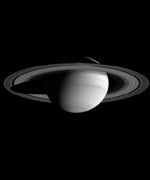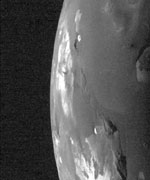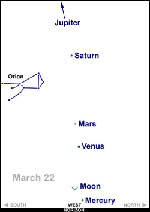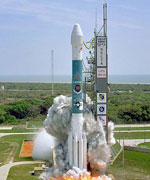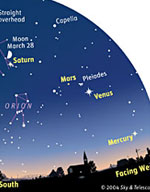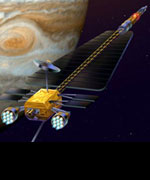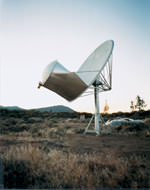
Image credit: SETI Institute
Investor and philanthropist Paul G. Allen has committed $13.5 million to support the construction of the first and second phases of the Allen Telescope Array (the ATA-32 and ATA-206), the world’s newest multiple use radio telescope array. The ATA will eventually consist of 350 ? 6.1-meter dishes (ATA-350), when construction is completed late in the decade. The announcement was made today by Thomas Pierson, chief executive officer for the SETI Institute, a leading astrobiology institution with the mission of exploring the origin, nature and prevalence of life in the universe. The ATA is a partnership between the SETI Institute and the Radio Astronomy Laboratory of the University of California, Berkeley (RAL).
Today’s announcement follows the successful completion of a three-year research and development phase which was originally funded by an $11.5 million gift from the Allen Foundation. The R & D proved that one of the primary advantages of the array design ? its scalability ? makes it possible for the ATA to conduct scientific investigations as soon as the first 32 dishes are installed.
Pierson also announced that the ATA-32 is scheduled to begin conducting scientific investigations by the end of 2004, significantly earlier than the 350 element array can be completed.
The ATA will be a general-purpose radio telescope that will provide fundamentally new measurements and insights into the density of the very early universe, the formation of stars, the magnetic fields in the interstellar medium, and a host of other applications of deep interest to astronomers. At the same time, this 21 st Century radio telescope will also have the capability to search for possible signals from technologically advanced civilizations elsewhere in the galaxy.
“I am very excited to be supporting one of the world’s most visionary efforts to seek basic answers to some of the fundamental question about our universe and what other civilizations may exist elsewhere,” said Paul G. Allen, primary funder of the ATA. “I am a big proponent of leveraging revolutionary technology and design and applying it to important problems in science. The developments taking place with this new instrument will not only enables us to realize a lot of bang for our research and development buck, but it will also change the landscape of how telescopes will be built in the future. An instrument of this magnitude, which will result in the expansion of our understanding of how the universe was formed, and how it has evolved, and our place therein, is the reason I am the primary supporter of its development, design and construction.”
Allen’s $13.5 million funding, structured as a challenge grant, will allow construction and operation of the first phase of 32-dishes by the end of the year. It will also support construction of the second phase of 174 additional dishes (the ATA-206), which is contingent upon fulfilling the Foundations’ challenge grant, in response to which the Institute will raise $16 million in additional support.
?It is especially thrilling to see the Allen Telescope Array approach its first significant milestone,? said SETI Institute CEO Tom Pierson. ?We are grateful for the additional support from the Allen Foundation that is making this new facility ? and further discovery ? possible. Mr. Allen and his Foundation have set the bar high. Mr. Allen’s support of this worthwhile project, when matched by other supporters of radio astronomy and SETI, will quickly bring this project to fruition.?
The ATA is the result of a multi-faceted private-public partnership between the SETI Institute and the RAL. It differs in practice, appearance, and cost from traditional radio telescopes currently in use. When completed, the ATA-350 will be among the world’s largest and fastest observing instruments.
Rather than a single enormous dish or several large dishes, the ATA will be constructed using hundreds of specially produced small dishes. The telescope will incorporate innovative technologies and modern, miniaturized electronics in concert with increasingly affordable computer processing. These new technologies, combined with the ability to conduct continuous observations, will increase SETI search speed by 300 times over previous efforts and simultaneously allow astronomers to conduct complex radio astronomy projects requiring long-term observations. And the instrument will achieve these goals at one-fifth the cost of traditional radio telescopes of comparable collecting area and complexity.
In its first phase, the ATA-32 will have more antennas than any of the world’s other centimeter-wavelength radio telescopes. The individual antennas will be linked by fiber optics. The fiber, power, and air distribution systems will be installed in ten-antenna ?nodes,? an efficient way to maintain the cool operating temperature required by the equipment.
The ATA-32 will observe in the direction of the galactic anti-center to detect primordial deuterium, study dark matter in nearby dwarf galaxies, generate maps of polyatomic molecules in molecular clouds, and conduct a SETI survey of the inner galaxy.
?I am eager to begin observing on the ATA,? commented Dr. Jill C. Tarter, ATA project leader and Director of the Center for SETI Research at the Institute. ?Conducting observations 24/7 is a dream come true for any astronomer, and it is particularly exciting for the Institute’s astronomers, who have been constrained by limited time on other large centimeter wavelength telescopes. Finally, our tools are becoming commensurate with the size of our task.?
Scientists believe that radio waves, such as those commonly produced by a variety of technologies on Earth and traveling at light-speed through interstellar space, may offer the easiest way to detect evidence of a technologically sophisticated civilization elsewhere in the galaxy. With sufficient collecting area, it is possible to detect signals from a distant technology that are no more powerful than those produced on Earth today.
Dr. Leo Blitz, professor of astronomy and director of the Radio Astronomy Laboratory at UC Berkley said, “The ATA will revolutionize radio astronomy, making it possible to provide answers to the two biggest questions in astronomy: How did we get here? Are we alone?” Blitz went on to say, “The ATA’s ability to make radio images over large swaths of sky, to make measurements over an unprecedented range of radio wavelengths, and its ability to do several kinds of observations at once, provide a power and flexibility that will allow astronomers to address whole areas of astronomy that are currently inaccessible. Because of the telescope’s unique capabilities, I expect that we’ll discover things we don’t even know are out there.”
Construction of the ATA is underway at the Hat Creek Observatory, 290 miles northeast of San Francisco on a site operated by the RAL. The Hat Creek Observatory is located in an area that is ?radio quiet,’ thereby reducing the level of interfering signals from man-made sources.
Original Source: SETI Institute News Release
